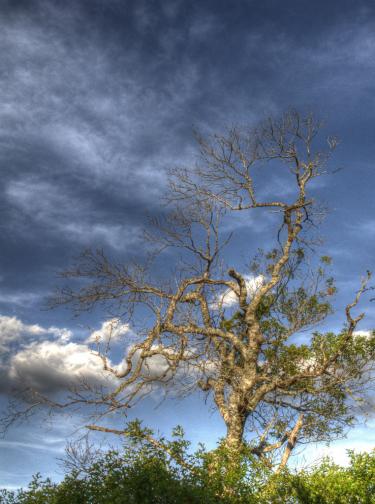How drought affects your forest
Drought affects trees directly by slowing or arresting growth, and causing injury or death. It also affects them indirectly, by increasing their susceptibility to wildfire, insect pests and disease. A drought may be short-lived, perhaps lasting one growth season, but its impact on a tree’s health—and, ultimately, a forest’s—can last much longer.
Trees have evolved protective mechanisms to deal with water stress, but there are many external factors that determine the effects of drought, including soil composition and topography, as well as the mix, age and density of trees. For example, soils high in clay tend to retain moisture better than sandy ones but trees put down shallower roots in clay, making them more susceptible to water shortages. All these make the relationship between drought and tree health a complex one.
Most plants are 80 to 95 percent water. They use it for transpiration (the release of water vapor through openings in the leaves called stomata), but also to produce energy, in the form of carbohydrates, through photosynthesis.
Under drought conditions, plants may close the stomata in their leaves to limit transpiration and thereby conserve water. If the shortage of water is prolonged, photosynthesis will cease, along with the plant growth it supports. Plants will also drop their leaves to conserve water. If drought persists, trees will eventually die.
Short-term effects of drought:
Deciduous trees, which can drop leaves to decrease the demand for water, tend to withstand dry spells better than conifers, but both types will show signs of water stress. Here are some signs that your woods are under stress from lack of water:
Deciduous Trees
- Wilted leaves: The broad leaves of most hardwoods wilt when water is in short supply. However, some species, such as oak, tend to be more resistant to it. Wilting usually happens during the day, followed by a recovery at night. This is called temporary wilting. When a drought worsens, the trees may progress to permanent wilting.
- Curled, warped or crinkled leaves.
- Scorched leaves that are brown along their edges.
- Discoloration (brown or yellow).
- Dropped leaves.
Conifers
- Second-year needles turn yellow or red.
- Needles drop prematurely, i.e., before two years.
- Bark beetle attack.
Long-term effects of drought:
- Poor radial growth in post-drought year(s) because food stores are quickly used up.
- Increased susceptibility to attack by insect pests such as the bark beetle and other diseases.
- Dieback of the tree’s crown.
- Decline and death.
How can I get more tips?
It’s simple! Enter your email below.

